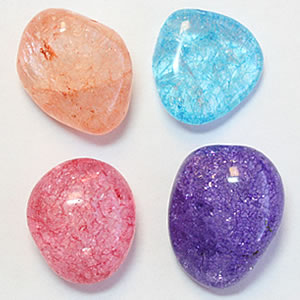Crackle Quartz
Intensely fractured quartz that is often dyed.

Tumbled Crackle Quartz: Four tumbled stones composed of crackle quartz that have been dyed orange, blue, purple and red. Crackle quartz can be dyed to any color that the manufacturer desires. It is often dyed outrageous colors to attract attention. Its sparkly appearance appeals to many people. Click the image above for an enlarged view. You should be able to see dye concentrated in the fractures. This is a diagnostic property of crackle quartz.
What Is Crackle Quartz?
Crackle quartz is a crystalline quartz that has been intentionally fractured by people. They usually heat rock crystal or slightly translucent quartz to a high temperature, then suddenly quench it in cold water. The shock of sudden cooling causes a network of tiny fractures to propagate through the quartz.
If dye is added to the quenching water, it will enter any surface-reaching fractures and flow, by capillary action, deep into the quartz. The deep penetration of dye produces a rich color in the quartz.
The result is a transparent colored stone that sparkles when it is moved under bright light. The sparkles are produced as light enters the stone, strikes an internal fracture surface, and reflects back to the eye of the observer.
How to Identify Crackle Quartz
Crackle quartz is easy to identify. Suspect it if you see tumbled stones with outrageous colors - colors that are usually not found in natural stones. Manufacturers use dye in colors that will attract attention and stand apart from other stones.
Next, if you look at the stones closely, you can see dye concentrated in the fractures. The area between the fractures remains clear quartz. Use a hand lens, a magnifying glass, or a microscope to get a closer look.

What Are the Uses of Crackle Quartz?
Many people enjoy crackle quartz because of its bright colors and the sparkles that it emits when handled or worn in jewelry.
Tumbled stones are the most common item made of crackle quartz. The quartz is tumbled and polished before the quench crackling is done. Quartz that had first been crackled would not survive the tumbling process without breaking.
Tumbled stones of crackled quartz are sold in many crystal shops, rock shops, online stores, and just about anywhere that tumbled stones are sold. Their bright colors and sparkly appearance cause them to stand out among other tumbled stones in retail displays. Crackle quartz is a good seller because of its attention-grabbing appearance.
Crackle quartz is often used to make wire-wrapped and other types of jewelry. Sometimes crackle quartz is sold in the rough, often as dyed crystal segments. These can be less appealing than tumbled stones because they often have sharp edges and surface-reaching fractures caused by the quench crackling process.
Crackle Quartz Durability Issues
Because crackle quartz is highly fractured, it is more fragile than other types of quartz. In fact, it is one of the least durable tumbled stones. We used to sell a tumbled stone mixture that included pieces of crackle quartz. A ten kilo bag of that mixture almost always contained numerous broken stones (mostly crackled quartz) and a good handful of broken quartz fragments in the bottom of the bag.
We stopped selling that mixture. Why? Pieces of crackled quartz would often break during shipment from our office to the customer. These disappointed our customers and earned complaints. We also decided that broken pieces of crackled quartz presented a safety hazard with the product, especially if the stones are handled by children.
We often see crackle quartz beads. We think that they will be unreasonably fragile in that use. Durability problems are the reason that you almost never see crackle quartz as cabochons. Who wants to work hard cutting a quartz cabochon and then see it break into pieces during the quench crackling process? Good cabochon cutters work too hard to intentionally risk their product.
RockTumbler.com Authors
 |
Hobart M. King has decades of rock tumbling experience and writes most of the articles on RockTumbler.com. He has a PhD in geology and is a GIA graduate gemologist. He also writes the articles about rocks, minerals and gems on Geology.com. |

